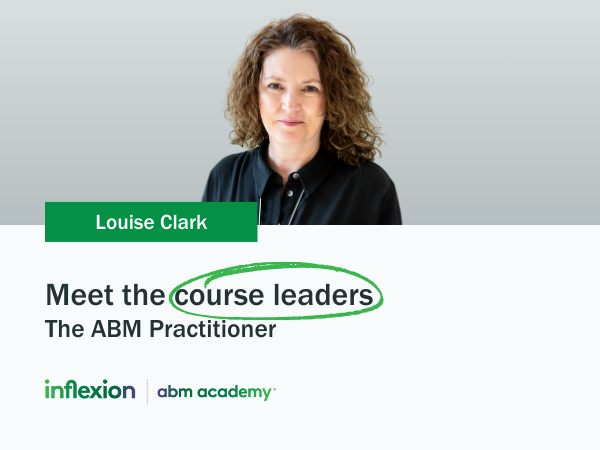In this edition of our ABM Academy alumni spotlight series, we turn our attention to someone whose eight years of ABM experience at a global technology leader have shaped a distinctly pragmatic approach to account-based marketing.
Meet Mercedes Calvo
Mercedes is marketing senior director at Red Hat, the world’s leading provider of enterprise open source solutions. As a subsidiary of IBM since 2019, Red Hat serves more than 90% of US Fortune 500 companies, delivering high-performing Linux, hybrid cloud, container, and Kubernetes technologies that power the world’s most critical business infrastructure.
With a degree in public relations from Universidad Argentina de la Empresa (UADE) and a master’s in marketing and business from the same institution, Mercedes has built a distinguished career spanning over 20 years in B2B marketing, communications, and marketing strategy. Her experience spans diverse industries including automotive, IT, and manufacturing, with previous roles at Hitachi Data Systems before joining Red Hat.
At Red Hat, Mercedes has been instrumental in developing and extending the ABM methodology that began with key telecommunications accounts eight years ago and has since expanded to other strategic industries. Her work focuses on customer retention and supporting future growth through customised marketing plans aligned with each account’s specific challenges and opportunities.
What sets Mercedes apart is her refreshingly practical perspective on ABM risk and measurement. Rather than viewing ABM as inherently risky, she sees it as a strategic contribution – provided it’s properly aligned with business objectives and sales teams. We spoke with her about her journey, her philosophy, and what truly matters in ABM.
The interview
You’re at a dinner party and someone asks what you do – how do you explain ABM?
ABM is a methodology that allows the development of a marketing strategy based on the needs of each customer, their challenges and opportunities.
How did you get into ABM? Was it intentional or by accident?
At my previous company, I received training in ABM to develop customized marketing plans for customers with the greatest purchasing potential.
At Red Hat, we developed the methodology for key Telco accounts over eight years ago and extended to strategic accounts in other industries where we aim to retain and support their future growth.
What’s the biggest risk you’ve taken in your ABM career, and did it pay off?
ABM investments are only risky if they aren’t aligned with the account’s business plan. If the plan is truly justified and aligned with the sales teams based on identified priorities and opportunities, the execution of different initiatives only contributes to positioning and expansion within the account.
What was your ‘lightbulb moment’ during the Academy course?
I found the entire course extremely interesting, practical, and useful. If I had to choose a key moment, it was the way we defined objectives and how we can measure ABM performance.
What’s in your ABM toolkit that you couldn’t live without – and what’s the most overrated thing everyone raves about?
Building an ABM dashboard to track relationship, reputation and revenue improvements against baseline data is key, and also generating an Executive Engagement plan to reinforce or create relationships with key decision makers.
The most overrated? Expensive activities designed to create customer experiences, which are difficult to measure. For example, sponsoring internal events at the client’s site with disproportionate investments. We should prioritize investments in events with defined objectives for the account, such as visits to the Executive Briefing Center or Customer Success Days.
Fast-forward five years – what does success look like for you?
Success can be measured by expansion with each client, through the generation of new business to support their growth, as well as customer loyalty and customer satisfaction in every interaction with Red Hat.
If the customer continues to choose Red Hat as a consultant and a partner to support their growth in the market in the upcoming years, we will be confident that our ABM work jointly with the Sales team is paying off.
If you could give aspiring ABM-ers one piece of advice, what would it be?
Always maintain the customer’s perspective, not the company’s. Focus not on selling, but on understanding their needs, challenges, and opportunities, to offer a concrete value proposition tailored to their needs.
The takeaway
Mercedes Calvo’s approach to ABM offers a masterclass in practical, measurement-driven marketing. Her most compelling insight challenges a common perception: that account-based strategies carry inherent risk. Mercedes reframes this entirely. ABM investments aren’t risky when they’re properly aligned with an account’s business plan and based on identified priorities and opportunities developed jointly with sales teams. When this alignment exists, ABM execution simply contributes to positioning and expansion within accounts. It’s a perspective that shifts ABM from being viewed as a gamble to being recognised as a strategic contribution.
This pragmatic philosophy extends to her approach to measurement and tooling. Rather than chasing complex technology platforms or elaborate customer experience initiatives, Mercedes focuses on two fundamental elements: building an ABM dashboard that tracks relationship, reputation, and revenue improvements against baseline data, and creating executive engagement plans to reinforce or establish relationships with key decision-makers. These aren’t flashy tools, but they’re precisely what’s needed to demonstrate ABM’s impact and ensure that marketing efforts reach the people who matter most.
Her stance on what’s overrated in ABM is particularly noteworthy. Whilst many organisations invest heavily in expensive customer experience activities – such as sponsoring internal client events with disproportionate budgets – Mercedes questions whether these investments can be meaningfully measured. Instead, she advocates for events with defined objectives for each account, such as visits to the Executive Briefing Centre or Customer Success Days. These targeted engagements deliver clearer value and more measurable outcomes than broad, expensive sponsorships.
Mercedes’ vision for success looks beyond traditional pipeline and revenue metrics to focus on something more enduring: customer loyalty and satisfaction in every interaction with Red Hat. Her goal is expansion with each client through generating new business that supports their growth. If customers continue choosing Red Hat as a consultant and partner to support their market growth in the coming years, she’ll know that the joint ABM work with the sales team is paying off. It’s a long-term perspective that recognises ABM’s true value lies not in quick wins but in building lasting partnerships.
Perhaps most valuable is her advice to aspiring ABM-ers: always maintain the customer’s perspective, not the company’s. This seemingly simple guidance represents a fundamental shift in mindset. It means focusing not on what you’re trying to sell, but on deeply understanding customer needs, challenges, and opportunities so you can offer concrete value propositions tailored to them. This customer-first philosophy has guided Mercedes through eight years of ABM evolution at Red Hat, from an initial focus on telecoms accounts, to expansion across strategic accounts in other industries.
At Red Hat, Mercedes has demonstrated that effective ABM doesn’t require expensive experience marketing or complex tooling – it requires clear alignment with sales and business objectives, rigorous measurement against baselines, executive access, and an unwavering focus on the customer’s perspective. Her work proves that pragmatism, when combined with genuine customer focus, delivers both measurable results and lasting relationships.
Want to develop your own customer-first ABM approach? Our next ABM Academy cohort is now enrolling. Discover our upcoming courses here
Our next alumni spotlight arrives next week, featuring another outstanding practitioner from our community.




